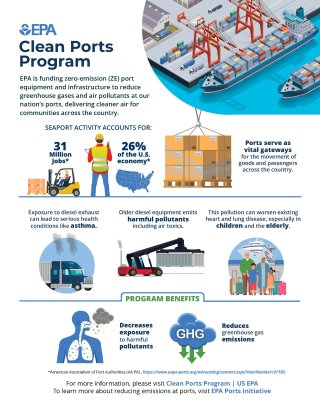EPA invests $3B into clean ports
EPA opens two grant competitions funding zero-emission port equipment, infrastructure and planning to tackle the climate crisis, reduce pollution and advance environmental justice
SEATTLE -- Yesterday, the U.S. Environmental Protection Agency announced the launch of the $3 billion Clean Ports Program to fund zero-emission equipment, infrastructure and climate planning at U.S. ports.

The funding opportunities were created under President Biden’s Inflation Reduction Act — the largest climate investment in history — and will advance environmental justice by reducing diesel pollution from U.S. ports in surrounding communities, while creating good-paying jobs.
"Few areas in the country understand the importance of ports more than those of us in the Pacific Northwest,” said EPA Region 10 Administrator Casey Sixkiller. “They bring jobs, goods and connect us to the world. Through the Clean Ports Program, EPA wants to assist this vital industry in transitioning to cleaner technology and creating healthier communities. We encourage all the ports in Alaska, Idaho, Oregon and Washington to apply.”
“Washington state knows better than anyone just how important our ports are—they truly are the gateway to the world for so many people and businesses,” said Senator Patty Murray. “I was at the Port of Tacoma last week and have seen firsthand how our ports are putting to good use funding we passed in the Bipartisan Infrastructure Law, including major investments in decarbonization—I’ve also heard directly from Port Commissioners across our state about how excited they are to apply to the Clean Ports Program. Thanks to the Inflation Reduction Act, this program is an exciting opportunity for Washington state ports to compete for major federal funding to help them transition to fully zero-emissions operation, reducing pollution in nearby communities and helping to tackle climate change—I encourage ports everywhere in Washington state to apply.”
The Clean Ports Program is designed to help ports across the country transition to fully zero-emissions operations — serving as a catalyst for transformational change across the freight sector. To achieve this, EPA is releasing two separate Notice of Funding Opportunities:
- The nearly $2.28 billion Zero-Emission Technology Deployment Competition will directly fund zero-emission port equipment and infrastructure to reduce mobile source emissions at U.S. ports. Eligible uses of funding include human-operated and maintained zero-emission cargo handling equipment, harbor craft and other vessels, electric charging and hydrogen fueling infrastructure, and a number of other technology investments. Applications under this competition will be evaluated under multiple tiers in order to ensure that funds are distributed across ports of different sizes and types, and to ensure funding for ports serving Tribal communities.
- The approximately $150 million Climate and Air Quality Planning Competition will fund climate and air quality planning activities at U.S. ports — including emissions inventories, strategy analysis, community engagement, and resiliency measure identification.
Together, these opportunities will advance next-generation, clean technologies that will more safely and efficiently drive the movement of goods and passengers at our nation’s ports, a critical part of America’s supply chain infrastructure while reducing pollution and advancing environmental justice.
The funding for the two grant competitions is available to port authorities; state, regional, local, or Tribal agencies that have jurisdiction over a port authority or port; air pollution control agencies; and private entities that apply in partnership with an eligible entity above, and that own, operate or use facilities, cargo-handling equipment, transportation equipment, or related technology of a port. The funding can be used for projects at water ports (coastal and inland) as well as projects at facilities where goods are transferred between rail cars and trucks (dry ports).
Ports are the transportation and commerce hubs that make the U.S. economy hum. In our global economy, efficient and effective ports are central to our economic viability and prosperity. At the same time, they are places where large concentrations of diesel equipment converge — including ships, trucks, rail, and non-road machinery. These diesel engines, particularly older engines found in many ports, operate near where people live, work, and play, emitting air pollution that can harm human health and contribute to climate change. This historic investment in clean technologies at ports that reduce exposure to air pollution will protect public health, particularly for communities surrounding ports. The Clean Ports Program will also help to ensure that meaningful community engagement and emissions reduction planning are port industry standard practices.
The new program builds on the success of EPA’s Ports Initiative and the Diesel Emissions Reduction Act programs, which have invested over $196 million to implement 207 diesel emissions reduction projects at ports with an additional $88 million to multi-sector projects that involve ports. Using the Ports Initiative and DERA’s strong foundation as a launchpad, the Clean Ports Program will drive transformational change across the freight sector. This new Clean Ports Program is one of several complementary programs funded by the Inflation Reduction Act and Bipartisan Infrastructure Law that can help reduce emissions at ports, including the Department of Transportation’s Port Infrastructure Development Program, which will be releasing a NOFO shortly. Visit a new interagency webpage summarizing federal funding opportunities for low- to zero-emission port technologies.
In addition to protecting human health and the environment, the program will create new jobs in the domestic clean energy sector and enhance U.S. economic competitiveness, through innovation, installation, maintenance, and operation of zero-emissions equipment and infrastructure. The program’s historic investment in zero-emission port technology will promote and ensure the U.S. position as a global leader in clean technologies.
